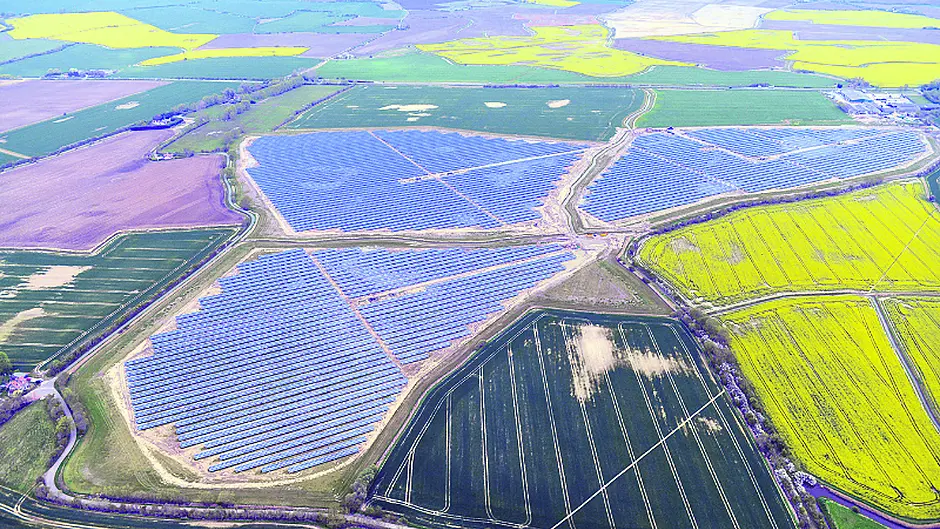The founder of the firm behind two proposed solar farms for Bandon tells Siobhán Cronin that the energy source is clean, quiet and non-invasive, and can help us meet carbon targets
The founder of the firm behind two proposed solar farms for Bandon tells Siobhán Cronin that the energy source is clean, quiet and non-invasive, and can help us meet carbon targets
THE Dublin-based energy company that is proposing to build two large solar farms in Bandon has suggested that up to 220 people will be employed in the initial construction phase.
The company – BNRG Renewables – is entering into a joint venture with French firm Neoen to build two solar farms which will cover a combined 80 or so acres.
The company is also proposing to build a solar farm in Midleton at the same time, and it is expected the seven full-time (mostly maintenance) positions will be shared between Bandon and Midleton.
The proposals, which have yet to get planning permission, may raise some eyebrows among Cork county councillors, who have already been debating the issue.
In November, a Council official wrote to the Department of Housing, Planning and Local Government, pointing out that members had passed a resolution on the issue.
The resolution stated that the members were calling on the Department to ‘invoke a moratorium on solar energy power plants in Cork County until the necessary guidelines regarding large scale solar developments are in place.’
It added that councillors were calling for ‘clear, strict, national guidelines’ to be put in place immediately.
The proposal came about after a discussion at a meeting of the Bandon Kinsale members, who expressed fears over the number of planning permissions being sought for solar farms, in the absence of any policies on such farms.
Members referred to the increasing numbers of windfarms in the region, which some people believe will have a negative impact on tourism, due to the turbines on the landscape.
In response to such fears, David Maguire of BNRG told The Southern Star that solar farms and windfarms were not comparable.
‘These solar farms are generally flat and won’t exceed about 2.5m in height (8.2ft), so you won’t really see them. You won’t hear them as there is no noise from them, and there is no emissions,’ said Mr Maguire.
He said they would connect with the national ESB network through a low voltage system and most of the cables would be underground, connecting to the local sub-station.
‘This is a relatively new source of energy for Ireland, but we are the last EU member state to have solar farms. We are really coming very late to the game,’ he said.
But, he admitted, this also brought advantages. ‘Of course, because of that, we can learn from the mistakes of others. Best practice has matured – firms were using concrete at the start, but now the technology is very light.’
Mr Maguire said the carbon footprint of solar farms is a lot less than windfarms, and they can be designed and constructed to allow sheep to graze on the site – although cattle would be too heavy.
‘While the sites can be quite sizeable, only about 5% of the site is used,’ he added.
Solar farms are also being seen by some farmers as a valuable source of income. ‘We lease the sites long-term, so it’s a good way of diversifying farm incomes. The solar lease can be a good back-stop for a farm. Farmers get a premium above the agricultural rent rate – and they can bank on that income. It’s a solid rent while they can still use it for agriculture,’ he said.
Ireland is not going to meet its renewable energy targets, but solar farms give it the best chance of addressing the gaps, Mr Maguire suggested.
‘Ireland is on a watch list now and there will be significant fines – between €100m and €120m for every 1% we are out – imposed if we don’t meet the targets by the end of 2020,’ he pointed out. ‘We cannot use wind alone because of the [slow] planning process.
‘Solar is a very swift way of getting towards the targets. It is also the cheapest source of renewable energy after wind and it is closing that gap. Once you get through the construction phase, it is very quick.’
The national guidelines on planning for solar farms will not be available for about another 12 months, Mr Maguire believes, adding: ‘If we wait to start these in 2018, then we will miss the 2020 target.’
He said he would be concerned about the lack of current guidelines ‘if solar was genuinely contentious, but there is no, or minimal, visual impact, no noise and no emissions.’
He said there should be ‘no impact at all, if they are properly located’. When questioned on the lack of guidelines, and the very real fear that some people have about such large sites being constructed before the guidelines are complete, Mr Maguire said: ‘The planning system, in itself, is challenging enough. Planners have a pretty good handle on this, and are asking all the right questions. They are being pretty rigorous in their assessments and are scrutinising everything and are not allowing anything to go through if they are sited incorrectly.
‘It’s as simple as that. When you look at what has been accepted, there are more modest numbers [of solar farms] than we have been hearing about. I have no concerns that any “rubbish” is getting through.’
He said the Bandon construction phase would use a mix of Irish and non-national workers, ‘We would expect all the civil works to be carried out by Irish companies and workers. The mechanical installation may be carried out by either Irish or EU firms and workers and the electrical installation is likely to be Irish companies and workers. These elements of work will be going out to tender in early 2018.’
It is currently assembling its planning studies and has promised ‘a round of public consultation’ before submitting the plans with the County Council. ‘This is likely to be in the next month or two,’ said Mr Maguire.
The Dublin firm already has up to €240m worth of projects constructed throughout the EU, with only one of these ever being rejected. ‘That was in the UK,’ said Mr Maguire. ‘And that was more for political reasons than anything else. In fact, the local authority had recommended approval. Now there is no further need, in the UK, for solar farms, as they have already deployed 12gw of power from them.’
He added that the Irish Solar Energy Association has been consulting with local authorities, and interested parties like Birdwatch Ireland, the EPA and An Taisce, and it will be issuing its own guidelines in the next month.
Solar power uses the same kind of technology as solar screens on laptops or on calculators. It works on light, rather than heat, and Ireland actually produces very good light – about 70-80% of the quality of light produced in France – which has a large solar power industry.
About two-thirds of all the energy coming from solar farms is produced in the autumn and spring times, and the other third in winter. ‘We in Ireland, insanely, import about 88% of all our energy needs,’ said Mr Maguire. ‘And wind is very successful. We actually have the lowest costs per capita for renewable energy. ‘Solar energy is a good fit for us because of our climate and weather patterns. When it is windy, there is not usually a lot of light, and vice versa, so obviously wind and solar both work well on the grid.’
Smog reduces the efficiency of the panels, so Ireland’s relatively clean air is another good boost for this form of energy. ‘And solar actually performs better, the cooler it is. Finland, for example, is a very good location also,’ he said.
Mr Maguire also maintains solar power can offer an economic boost to rural communities.
Cllrs’ moratorium proposal ‘won’t impact’on current planning
CORK County Council chief executive Tim Lucey has said that the recent proposal from councillors, seeking a moratorium on solar energy plants in Cork, would ‘not impact on the manner on how the Council decides on applications and any decisions made are sound even without the guidelines.’
Mr Lucey added that the Council is ‘more than open’ with proposals and has its own energy section with significant benefit from EU work, and this will continue.
‘The Council is committed to having an energy section into the future,’ he added.
The proposal by Cork County councillors to seek a moratorium on solar farms was proposed by Cllr Kevin Murphy ands seconded by Cllr Rachel McCarthy recently. At the meeting which discussed the issue, members made the following points:
• National Guidelines need to be enacted to ensure solar farms are part of our energy programme;
• All members support renewable energy but national guidelines are needed;
• There has been no consultation with the residents in the area and how the plant would affect their living conditions;
• 200,000 acres has been committed nationally for these farms;
• Number of applications coming down the line is a concern;
• There needs to be more control in where they are placed;
• Planners are not at fault to grant permission but national guidelines are needed;
• Cork will be a big draw for renewable energy need to see how this will affect the whole county;
• Need direction from the government on how to approach this;
• Is the Council legally entitled to call for a moratorium on applications?
• Mistakes have been made in the past with wind energy;
• We should not have to give up good agricultural land for this;
• We should exploit our solar assets but on marginal land only;
• Ireland is committed to produce 16% electricity by solar plants by 2020, highly challenging for the country;
• Council is required to consider all applications that come before it;
• Damning indictment on the Department – we need to look at renewables seriously into the future;
• Worrying that they want to bring local community into share of profits; educate people properly on what they are handing over.









